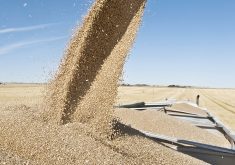You can’t market something until you know what you have to sell.
That’s the simple principle behind a grain marketing program designed to eventually connect milling wheat and durum producers to the end users.
“We’re not sure what we’re going to find,” said Gary Pike of Lethbridge-based Pike Management Group.
“We don’t know what we have.”
Pike’s Grain Attribute Advantage Program is designed to analyze samples of a farmer’s wheat or durum from particular areas of a farm. Several tests can be used to analyze the grain, but the most common one will be the test that millers and bakers use to analyze the wheat they plan to use.
Read Also

India slaps 30 per cent import duty on yellow peas
India has imposed a 30 per cent duty on yellow pea imports with a bill of lading date on or after Nov. 1, 2025.
When producers now deliver their grain, it is generally only rated by class and grade. Pike said millers need more precise analysis, because sometimes the qualities users need are not revealed in class and grade measurements.
“We had an experiment a couple of years ago where a No. 4 durum produced the better quality product than the No. 1,” said Pike.
Producers who sign up for the program receive special sample bags from Pike’s company that they use to hold samples from specific parts of their farms.
Once the samples are analyzed, the data will be collated by Pike and given to the producer. As the program collects more data from other farms, a producer will be able to see how well his fields are producing certain attributes compared to general results in the area.
Each producer’s data will be kept private and not revealed to industry, said Pike.
Once producers know whether they are producing grain with valuable attributes, and know whether they can consistently produce them every year, the next part of the marketing plan can be developed, Pike said.
Exactly how to connect millers and processors with producers hasn’t been worked out yet, Pike said. It could be done by producers using the Canadian Wheat Board’s buy-back program, by the wheat board working with the producer or by the miller working with the wheat board.
Producers will need to spend the time analyzing their farms’ grain before figuring who to sell it to and how to sell it.
“We know that this is not going to happen overnight,” said Pike.
“This program is going to take a period of years before we know if you’re consistently providing a particular attribute.”
About 60 large producers have signed up for the program so far, said Pike. The membership fee, which includes analyzing the information, is $2,500, and testing costs $130-$180 per bag, depending on which ones are performed.
Pike said knowing what you are producing is the first step in marketing it more effectively and getting more out of your land.
“The value of the data could influence the value of your land in the future,” said Pike.
“Information is very, very important in today’s agriculture.”















